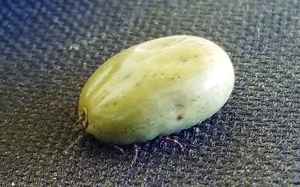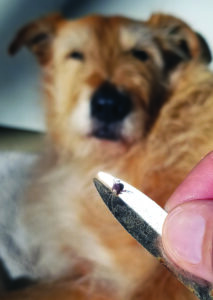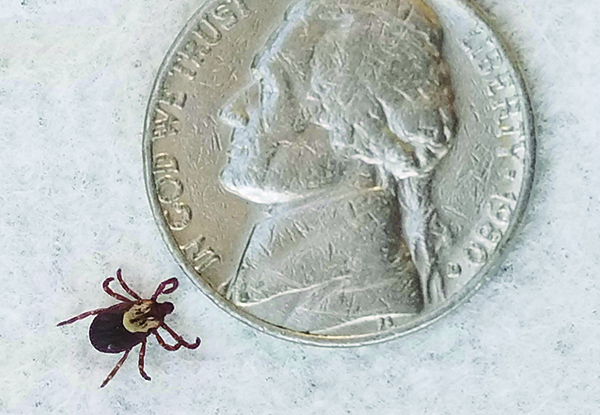Ticks are blood-sucking, disease-spreading parasites that are genetically related to spiders. They are found worldwide and pose considerable risk to your dog (and you!) because of the bacteria they carry and transmit through their bites – bacteria that can cause serious, even life-threatening illnesses, including Lyme disease. It’s important to defend your dog from ticks to the extent possible, and promptly remove any ticks you are unable to prevent from reaching your dog, in order to protect him from tick-borne disease.
KNOW THY ENEMY

There are two main types of ticks with very different anatomies and lifestyles. Hard ticks, members of the Ixodidae family, are the main concern for you and your dog due to their free-ranging life style. Soft ticks, members of the Argasidae family, tend to stick close to the nests or burrows of their hosts. This means we are less likely to encounter them when walking in the park or playing in the yard.
Ixodid ticks include the deer tick, also known as the blacklegged tick (Ixodes scapularis), the American dog tick (Dermacentor variabilis), the brown dog tick (Rhipicephalus sanguineous), the Gulf Coast tick (Amblyomma maculatum), the Lone star tick (Amblyomma americanum), and the Rocky Mountain wood tick (Dermacentor andersoni).
Ixodid ticks free range in the environment looking, or waiting, for their next victim. They hang out on vegetation, sticking two of their eight legs out and waving them around, in a behavior called “questing,” so they are ready to grab on to the next passerby. Once they have grabbed onto an animal, they crawl around and make their way down to skin. There they cut the skin with their mouth parts to make a feeding hole. Their saliva contains a cement-like material, which they spit into the hole to secure themselves tightly while they feed for days.
As if all this isn’t gross enough, once they reach a certain point in their feeding, they continuously regurgitate back into the host. This regurgitation is how they infect the host with the disease-causing organisms they carry within them.
Each of the diseases spread by ticks is caused by an infection with a bacteria or protozoa that is carried within the ticks. Each species of tick tends to carry different organisms within them, though some ticks may carry more than one pathogenic organism.
Most of the diseases caused by an infection of these tick-borne pathogens are named after the bacteria, protozoa, or virus they carry. Thus, anaplasmosis is caused by an infection of the bacterial species Anaplasma phagocytophilum. Babesiosis is caused by an infection with the protozoa Babesia microti.
Other infectious diseases spread by ticks include hepatozoonosis, Rocky Mountain spotted fever, Colorado fever, ehrlichiosis, and of course, the infamous Lyme disease.
Another deadly condition caused by ticks in dogs is called tick paralysis. Tick saliva contains a neurotoxin that causes a progressive paralysis in susceptible dogs. This will result in the death of the dog unless the tick is found and removed. Fortunately, if the tick is removed in time, most dogs will make a full recovery. (See “Tick Paralysis,” WDJ July 2013 for more detail.)
Signs of tick-borne diseases in dogs vary somewhat depending on the disease, but most include fever, lethargy, and inappetence. Some will cause anemia, enlarged lymph nodes, bruising, muscle pain, and joint aches.
The upside is that, while these diseases can be fatal if left untreated, most respond favorably to appropriate antibiotic therapy and supportive care, if diagnosed sooner than later.
Screening for these diseases, to catch them before they make your dog sick, makes good sense. This is easy to do, as the annual blood test recommended for all dogs, which originally only tested for heartworm disease, now additionally tests for antibodies for Lyme, ehrlichia, and anaplasma. Proactively screening for these diseases is the best way to ensure early detection and a good outcome, should your dog be exposed.

Whether your dog has been treated with a tick-preventative product or not, if you’ve been walking where ticks are likely to be, you should check your dog for ticks before letting her into the house (or car, if you’ve driven to a walking site).
A tape roller – the kind most of us dog owners carry to remove dog hair from our clothing – is a handy way to capture loose, crawling ticks on our dogs’ coats. Another way to remove loose ticks is to wipe down your short-haired dog with a microfiber cloth; if your dog has a thick or long coat, go over them with a brush or comb.
Check your dog again later in the evening, perhaps after dinnertime, when you and your dog are relaxed, and you can thoroughly feel your dog for any ticks who may have already bitten and attached to your dog.
KEEPING YOUR DOG SAFE FROM TICKS
Ticks, as opposed to fleas, are difficult, if not impossible, to control in the environment. They are ubiquitous – found literally everywhere in the world.
Additionally, they spend only a short amount of time on their hosts compared to the time they spend in the environment, they have amazing survival mechanisms, they reproduce like crazy, and they live a long time (they can go as long as two years without a blood meal!). Eliminating them from the environment, sadly, is impossible.
Your best bet is to avoid them if possible. If tick exposure is even a remote possibility, preventing them from attaching and transmitting disease is paramount. For humans, this means long-sleeved shirts, long pants tucked into our socks, bug spray, and keeping yards clear of long grass and leaf debris.
For our dogs, this means using an effective tick preventative.
Luckily, there are many good choices on the market now. Your choices for effective tick prevention boil down to oral products, topical products, or one very popular, highly effective collar.
* Oral preventatives. Oral products, like Nexgard (Boehringer Ingelheim) and Bravecto (Merck Animal Health), contain isoxazoline derivatives that negatively affect the tick’s nervous system, resulting in death of the tick.
Oral products are effective and convenient. The tick does need to bite the dog, however, so you may find dead ticks on your dog or in your home. It can take anywhere from 12 to 48 hours for the tick to die with these products. Since it takes at least 48 hours for a feeding tick to start regurgitating and transmitting disease, using Nexgard or Bravecto will effectively prevent tick-borne disease.
Oral products, as opposed to topical products, are absorbed systemically by the dog and distributed to all body tissues. They are gradually eliminated through the liver, unchanged, into the bile and out through the feces. They are eliminated without requiring any work by the kidneys or liver.
Oral products that contain a class of chemicals called isoxazolines can cause seizures in susceptible dogs, however, the incidence per doses sold is extremely low. Dogs who have experienced seizures prior to any exposure to these drugs are at the highest risk of an adverse response to them.
Merck uses an isoxazoline-class chemical called fluralaner in both its oral and topical products called Bravecto. According to Merck, no direct link has been made between the oral form of fluralaner in Bravecto and seizures (though Merck’s site says, “Use caution in dogs with a history of seizures”).
* Topical preventatives. Effective topical tick preventatives, like K-9 Advantix (Elanco, formerly Bayer) and Frontline Shield (Boehringer Ingleheim), contain pyrethroids like permethrin and flumethrin. Pyrethroids are insecticides, so they will kill the tick. But they also repel, which means no ticks biting or attaching to your dog. They do this by what’s called the “hot-foot” effect. The chemicals literally burn the ticks’ feet, so they want to get off the dog.
Another aspect of topicals, in addition to their ability to repel ticks, is that they are not systemically absorbed. They translocate to the skin’s oil glands, where they slowly dissipate over the next several weeks. They are waterproof, so swimming and bathing doesn’t reduce their effectiveness as long as it’s not within 24 hours of application.
*Tick collars. Our final category in tick preventatives is collars. In this author’s opinion, the Seresto collar (Elanco, formerly Bayer) is the only collar to choose.
The Seresto collar contains flumethrin and imidacloprid. It has the hot-foot effect for repelling ticks, and it paralyzes the tick’s mouth parts within 10 minutes. The ingredients are not absorbed systemically (testing of blood and tissue showed no detectable amounts). They collect in the skin’s natural oils, releasing small amounts of active ingredient daily. The collar remains effective for up to eight months. Dogs who swim a lot should have their collars replaced every five months.
Recently, USA Today reported that the Seresto collar was responsible for causing serious illness and deaths in dogs, but the allegations made in the article were refuted by both Elanco and the U.S. Environmental Protection Agency. The article made a lot of buzz, but most veterinarians, including me, were skeptical about its allegations; we just haven’t seen many adverse events caused by the collars.
And, again, the number of legitimately reported adverse events is minuscule compared to the millions of collars sold. No direct cause and effect has been discovered to date – and, given the number of counterfeit Seresto collars that have been intercepted by customs agents, the possibility is very good that at least some, if not many, of the adverse effects reported have been caused by counterfeit products with undetermined safety and efficacy. These counterfeits look very much like Elanco’s Seresto collars, right down to the packaging.
The best way to make sure that the product you are buying is not a counterfeit is to purchase only from your veterinarian or by sellers that are authorized by Elanco. To find authorized sellers, go to petbasics.com/where-to-buy.
* Please note:. If your dog experiences any adverse effect following the use of any tick preventative, keep a note of the type of product used (including its ingredients) and don’t repeat that product or use another product in its class. Instead, discuss alternatives with your veterinarian.
Also, we don’t recommend low-cost pesticide products that are sold over the counter in grocery stores and big-box stores. The lowest-cost products sold in these markets tend to have the highest rate of adverse effects and lowest effectiveness.
TICK BITES

What should you do if you find a tick on your dog, despite your best efforts to prevent this?
If you are comfortable removing the tick yourself, do so. If you are uncomfortable with this, call your veterinary clinic. A licensed veterinary technician will be happy to help.
If the tick does not appear to be engorged (big and fat from a large blood meal), the likelihood of disease transmission is low; the tick is unlikely to have regurgitated any pathogens into your dog yet.
If the tick is engorged, or if you just want to be sure your dog was not infected by the tick, schedule a tick test in six weeks. It takes six weeks for your dog to seroconvert (show detectable antibodies after exposure), so testing earlier could result in false negative results. If your dog shows any of the signs of tick-borne disease discussed above, see your veterinarian right away.
Some health departments and human hospitals offer testing of the tick to determine if it may have been carrying disease. These tests are not always reliable, and even if the tick tests positive for a disease, it does not necessarily mean it infected your dog. For these reasons, having your dog’s blood tested six weeks after the bite is a better recommendation.
Related Article
How to Remove a Tick from a Dog







I would have liked some discussion around a once a month oral solution our vet recommended and we have been using this year that is marketed to take care of ticks, fleas, heartworms, roundworms and hookworms called Simpatica Trio (solaner,moxodectin,pyrantel are the active ingredients according to the box). We love the convenience of getting tick and heartworm coverage in one monthly tablet.
What about the vaccine? I have had my dogs vaccinated for a few years now. I am a long time sufferer of Lyme . I also use seresto collars and live on a farm so ticks a major scare. I will say the collars work great!
I was expecting a more holistic approach. Surely there are non-toxic ways of dealing with this important issue. One that I’m trying right now is geranium essential oil as a topical application. I’m looking into using it as a supplement also. Anyone else tried non toxic approaches?
My holistic vet has told me that the potential for terrible consequences from tick-borne disease far outweighs the possible side effects from using something like a Seresto collar. She’s very conservative in her approach to traditional medicine with animals, meaning she doesn’t reach for drugs first (or in my dogs’ cases, ever), so when she told me that, I listened. And we use Seresto collars now.
Yes, the advice you’ve been given is accurate. This essay is wrong in its promotion of oral insecticides. It’s wrong to accept the assertion of a global pharmaceutical company engaged solely in for-profit manufacture, about the so-called “safety” of its products. There is certainly an association with a myriad of adverse effects from Bravecto, including those that may cost the life of your dog. I know people whose dogs have died, and one who went blind after ingesting this insecticide. This essay dismisses the situation with “…according to Merck” and that’s not what we’d expect from WDJ.
For anyone whose property is zoned to allow farm animals, another way to get rid of ticks is to get free range Guineafowl (or Guinea hens). They are a great way to control many pests.
I live in a suburban area, and for the last two years I’ve used Cedarcide (natural cedar essential oil in a spray commercially available). Neither my dog nor I got any fleas or ticks this year. I spray it in my porches that usually housed hornets, they too are gone as are the ants and spiders, etc. An added bonus is that I use it on my wood flooring and it looks amazing.
Very good, informative article. However, I very much agree with Peter’s comment above regarding Bravecto (Dec. 12th). My Lab had a scary neurological response to Bravecto, although he had been taking it for years. He was 9 1/2 at the time, and thankfully fully recovered, but when I looked into it online, there were tons of reported cases of neuro reactions, and worse. “According to Merck” isn’t reliable, although they were very good when called about it. I was also surprised to see that statement in WDJ. I did go ahead and report it to all the proper agencies. BIG lesson learned: no more 3-month doses. It’s an unnecessary risk for convenience. Topical is not systemic, so that’s what I use on my Lab, but it’s not my preference because it’s messy, and I have cats. My other dog gets the 1-mo. oral Nexgard now. For heartworm, i was using the “max” product, I switched to the “plus”, with less ingredients. The least amount of chemicals/pesticide, the better, especially as they age. They are also both vaccinated agaginst Lyme. And I’m out there with no protection! I’m surprised there’s no Lyme vaccine for people yet.
How do you dispose of the tick once it’s removed? I use tweezers for removal, any better suggestions?